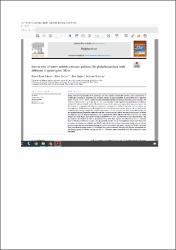| dc.contributor.author | Yılmaz, Hasan Emre | |
| dc.contributor.author | Bağda, Efkan | |
| dc.contributor.author | Bağda, Esra | |
| dc.contributor.author | Durmuş, Mahmut | |
| dc.date.accessioned | 2022-05-16T09:04:27Z | |
| dc.date.available | 2022-05-16T09:04:27Z | |
| dc.date.issued | 1 November 2021 | tr |
| dc.identifier.citation | Yılmaz, H. E., Bağda, E., Bağda, E., & Durmuş, M. (2021). Interaction of water soluble cationic gallium (III) phthalocyanines with different G-quadruplex DNAs. Polyhedron, 208, 115404. | tr |
| dc.identifier.uri | https://hdl.handle.net/20.500.12418/13127 | |
| dc.description.abstract | Small molecule-G-quadruplex DNA interaction has been gained considerable interest due to existence of G-quadruplex structures in telomeres and promotor regions of proto-oncogenes. In the present study, the interaction of 2(3), 9(10), 16(17), 23(24)-tetrakis-[(N-methyl-3-pyridyloxy)phthalocyaninato]chloro gallium (III) sulphate (TGaPc) and 2, 3, 9, 10, 16, 17, 23, 24-octakis-[(N-methyl-3-pyridyloxy) phthalocyaninato]chloro gallium (III) sulphate (OGaPc) with different DNA forms (ctDNA and G-quadruplex DNAs) was investigated. The interactions of compounds with DNA was extensively investigated by different methods, such as capillary gel electrophoresis (CGE) integrated with a high sensitivity LED-induced fluorescence detector, UV–Vis and circular dichroism spectroscopy, competitive dialysis experiments. UV–Vis. titrations and CGE studies showed that the two phthalocyanine compounds interacted with the G-quadruplex and ctDNA, but the binding affinity of TGaPc was high for AS1411. Dialysis experiments also supported the higher affinity of TGaPc to AS1411. CD studies showed that both TGaPc and OGaPc caused destabilization of Tel21 structure even at low concentrations. This was more or less observed in other G-quadruplex DNAs other than AS1411. The structure of AS1411 remained intact at binding stoichiometric ratios. The viscosimetric studies and gel electrophoresis studies have been used to explore the interaction of TGaPc and OGaPc with ctDNA. The viscosity experiments along with gel electrophoresis confirmed the intercalation binding for ctDNA with OGaPc and groove binding for TGaPc. All results show that these molecules interact with different DNA types at different strengths and different mechanisms and the binding affinity of TGaPc was high for AS1411. Therefore, these compounds have the potential for cancer treatment. | tr |
| dc.description.abstract | G-quadruplex DNA
Phthalocyanines
Interaction
Binding mechanism | tr |
| dc.publisher | Elsevier | tr |
| dc.relation.isversionof | https://doi.org/10.1016/j.poly.2021.115404 | tr |
| dc.rights | info:eu-repo/semantics/openAccess | tr |
| dc.subject | G-quadruplex DNA | tr |
| dc.subject | Phthalocyanines | tr |
| dc.subject | Interaction | tr |
| dc.subject | Binding mechanism | tr |
| dc.title | Interaction of water soluble cationic gallium (III) phthalocyanines with different G-quadruplex DNAs | tr |
| dc.type | article | tr |
| dc.relation.journal | Polyhedron | tr |
| dc.contributor.department | Eczacılık Fakültesi | tr |
| dc.relation.publicationcategory | Uluslararası Hakemli Dergide Makale - Kurum Öğretim Elemanı | tr |















